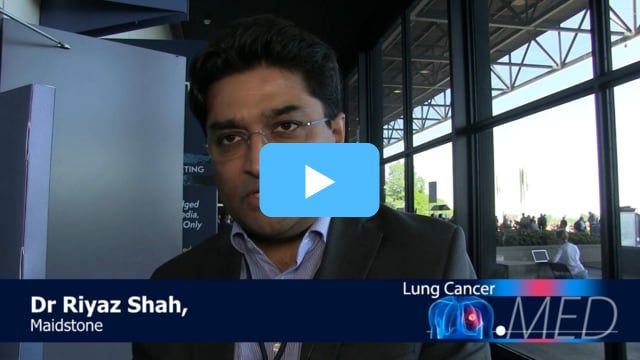Advertisment
ASCO 2018: KEYNOTE-042 shows OS

First-line treatment with the PD-1 inhibitor pembrolizumab showed an overall survival benefit compared to platinum-based chemotherapy in patients with locally advanced or metastatic non-small cell lung cancer and a PD-L1 tumour proportion score of at least 1…
Written by Thomas R Collins.
Dr Riyaz Shah (Maidstone) and Dr Jason Lester (Velindre NHS Trust, Cardiff) discuss how the data from KEYNOTE-042, KEYNOTE-407 and KEYNOTE-189 will guide UK practice.
First-line treatment with the PD-1 inhibitor pembrolizumab showed an overall survival (OS) benefit compared to platinum-based chemotherapy in patients with locally advanced or metastatic non-small cell lung cancer (NSCLC) and a PD-L1 tumour proportion score (TPS) of at least 1, according to findings presented here at the annual meeting of the American Society of Clinical Oncology. 1
“KEYNOTE-042 is the first study with a primary endpoint of overall survival to demonstrate superiority of pembrolizumab over platinum-based chemotherapy in previously untreated locally advanced or metastatic non-small cell lung cancer,” said presenter Dr Gilberto Lopez, Associate professor of medicine at the University of Miami.
No significant, cohort-wide progression-free survival (PFS) difference was seen between the arms. Patients with sensitizing EGFR and ALK alterations were not enrolled, and no crossover was allowed. An independent expert said that this lack of crossover was crucial in interpreting the results.
Patients included those with untreated locally advanced or metastatic NSCLC of any histology, a PD-L1 expression of at least 1%, an ECOG performance status of 0 or 1, no untreated or unstable central nervous system metastases, and no history of pneumonitis that required systemic corticosteroids.
A total of 637 patients were enrolled in the pembrolizumab arm and 637 in the chemotherapy arm, which included carboplatin and paclitaxel treatment for up to 6 cycles, with patients with non-squamous cancer strongly encouraged to get pemetrexed therapy as maintenance.
The portion of patients with the highest levels of PD-L1 expression — 50% TPS or greater — was balanced, with 299 such patients in the pembrolizumab arm and 300 in the chemotherapy arm, Dr. Lopes said. About a third of patients had a TPS of 1 to 19% in each arm.
At 2 years, the overall survival for all patients was 39.3% in the pembrolizumab group and 28% in the chemotherapy group (p=.0018).
But the greatest difference was seen among patients with PD-L1 expression of 50% or higher — with a 2-year overall survival of 44.7% in the pembrolizumab arm and 30.1% in the chemotherapy arm (p=.0003).
Overall, PFS at one year was 28% in the pembrolizumab group and 26.6% in the chemotherapy group, which was not a statistically significant difference. The one-year PFS for those with PD-L1 expression of 50% or more was 37.4% vs. 27.3%, which was significantly different (p=.017).
Duration of response, across all patients, was greater for those treated with pembrolizumab. At 18 months, 53.4% of those patients continued to show a response, compared to 30.4% in the chemo group.
Treatment-related adverse events (AEs) were higher in the chemotherapy arm — seen in 89.9% of patients compared to 62.7%. This trend continued for Grade 3 to 5 adverse events — 41% in the chemo arm compared to 17.8%.
But a similar number of patients discontinued treatment to due treatment-related AEs: 58 patients in the chemo arm, and 57 in the pembrolizumab arm.
“This better safety and activity profile of pembrolizumab suggests that it is an appropriate treatment for patients at any level of PD-L1 positivity,” Dr. Lopes said. “These data, therefore, confirm and extend the role pembrolizumab monotherapy as a standard first-line treatment for patients with PD-L1 expressing tumours.”
Dr Leena Gandhi, Director of thoracic medical oncology at New York University, said a critical point was that not all PD-L1 subgroups fared the same in the trial.
“You can see that this benefit is clearly being driven by the high PD-L1 subgroup,” she said, “and that the benefit is not at all as clear-cut for those with 1 to 49%, where a much larger percentage of patients are not benefitting from initial PD-1 therapy.”
The trial design is also vital to note, she said.
“I think the key feature of this study design was that no crossover was allowed in the context of the study, which differs from some of the other studies that have been done in this context.” That includes a first-line nivolumab-versus-chemotherapy trial2 with results published last year, in which there was no difference in overall survival between the groups. Crossover was allowed in that trial. And 60% of the patients in the chemotherapy arm had subsequent nivolumab therapy.
“I think,” Dr. Gandhi said, “that might explain some of the survival differences that we see.”
References
- Lopes G, Wu Y, Kudaba I, et al. Pembrolizumab (pembro) versus platinum-based chemotherapy (chemo) as first-line therapy for advanced/metastatic NSCLC with a PD-L1 tumor proportion score (TPS) ³ 1%: Open-label, phase 3 KEYNOTE-042 study. Abstract LBA4. Presented at the annual meeting of the American Society of Clinical Oncology. 3 June 2018.
- Carbone DP, Reck M, Paz-Ares L, et al. First-Line Nivolumab in Stage IV or Recurrent Non-Small-Cell Lung Cancer. N Engl J Med. 2017 Jun 22;376(25):2415-2426.





